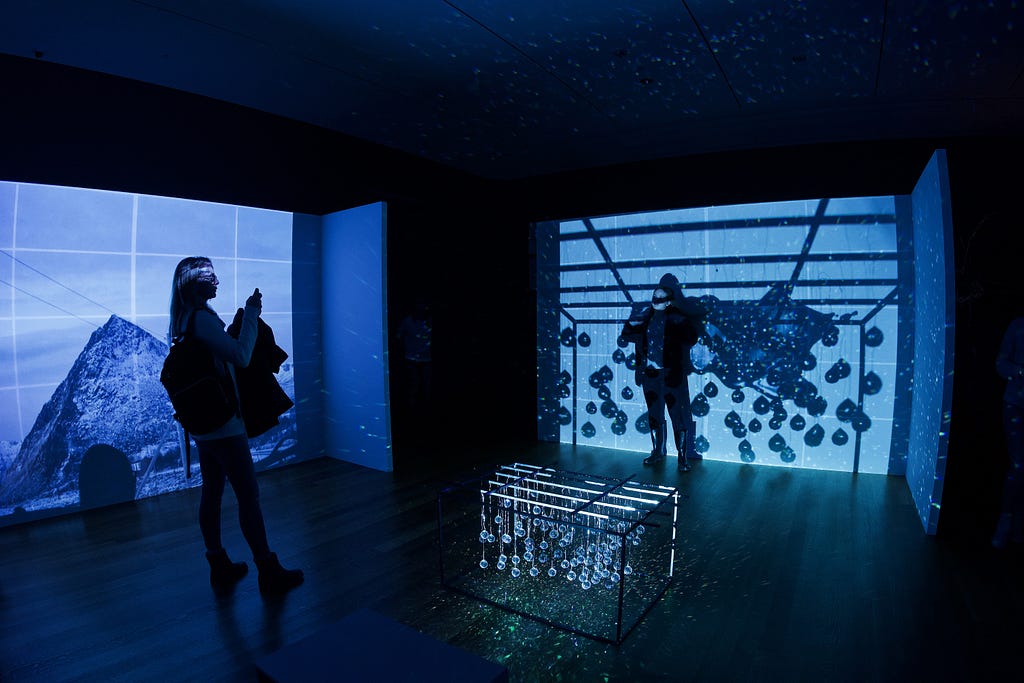Sorry We’re Closed: Integrating Digital with the Museum Strategy
April 1, 2019 - All

Construction. Often associated with traffic jams, loud noises, and general inconvenience, it can sometimes be forgotten that, in the end, the result can be much needed growth and ingenuity. As buildings age from the wear and tear of everyday occupation it becomes necessary to make updates and improvements from time to time. Museums are not immune to this reality and herein lies a major opportunity not just to update the building but to update their strategic goals: starting with a digital strategy. The team at Cooper Hewitt wrote about their experience working to complement the strategic plan with media and technology saying, “Often it feels like museums make decisions about the appropriate use of technology based upon short term internal needs — the need to have something ‘newsworthy’, the need to have something to keep their funders happy, and occasionally to meet the assumed needs of a specific audience coming to a specific exhibition.” However, a building project, whether it’s an expansion, a renovation, or a new building entirely, offers the ideal environment to consider the entire museum’s relationship with technology.
“Often it feels like museums make decisions about the appropriate use of technology based upon short term internal needs — the need to have something ‘newsworthy’…”
Closed: What to Consider
The Building
Looking at the museum as a whole there are several areas of operations to be considered when discussing a building project and potential temporary closure. Starting with the building itself. Poor infrastructure can sometimes go unnoticed until it becomes a problem, like it did at the Milwaukee Art Museum where water was leaking through the ceiling and wooden floors were buckling in the galleries before renovations were completed in 2015. In many recent cases, an expansion project results in more gallery space and therefore a new presentation of the collection. In fact, MoMA plans to draw from its permanent collection for all the opening exhibitions following a six month closure this coming summer/fall. These projects offer the opportunity to showcase some lesser-known works often hidden away in storage.
Additionally, as museum staffs grow the need for office space becomes a high priority. When it comes time to start the project the question becomes, where will the collection and all the employees go while the museum is closed? Often times this results in temporary exhibitions and workspaces. For example with The Frick Collection’s anticipated move into The Met Bruer building in the next couple of years. Technology and digital media are important to include when planning for a move to a new space, even if it is only temporary.

The Collection
Not only will a plan need to be in place for transporting the physical collection, there’s also the ideas behind the collection to be considered. Museum renovations resulting in closures can take anywhere from six months to six years, costing millions of dollars in construction costs and lost visitor revenue. How can the museum continue to fulfill its mission to provide the public with access to the collection and educational programming while the building is closed for such a long period of time?
The Brand
Another consideration to plan for is the museum’s brand. This is the time to consider the mission and vision and make updates as necessary. While updating the look and feel of the museum’s physical space it will most likely make sense to update the general look and feel of the branding. The Whitney took this approach before moving to a new building in 2015. In their words the updated brand served as a “visual ambassador” to the new building. A more modern facade may require a more modern logo and color palette.
The Community
Most importantly, any leadership team involved in a building project will need to consider the community, major stakeholders in the life of the museum. SFMOMA was cognizant of this when they implemented their Museums On The Go program from summer 2013 to early 2016 while closed for expansion. This is an ideal time to work with other institutions and organizations, to reach out to the public and go beyond the museum walls. More than ever, it’s important to meet visitors where they are because they can’t physically come to the museum.
How Does Digital Enhance the Strategy?
Online Presence
First and foremost, as an extension of the physical space the museum’s website plays an extensive role in communicating with the community. Often times museums will add a special section or even build separate websites dedicated to the building project. Tate created a special project section on their website, while the Tate Modern building project was underway, that even included a live image feed from the construction site and eventually a timelapse video of the construction. While mainly informational, these pages are still important for keeping the community up-to-date on the latest news with regards to the project before it even starts. Also of informational importance, if the museum is moving temporarily it will become necessary to update all instances of the museum location online with a note about the temporary location. This includes resources like Google quick links and Wikipedia. Additionally, if museum leadership decides to move forward with an updated look and feel the website can help familiarize the public with a new brand before the new or updated location even opens.
As curators plan opening exhibitions with less well-known artists they can use the website to showcase those works that are more often in storage. Featuring an artist of the day with digital surrogates of their work and supplemental narratives or materials online may help to get the public excited to see the works in person when the building re-opens. As well, many museum websites now feature virtual tours, which will be especially useful as a temporary solution to sharing the objects with the community.
Open Access Initiatives
Continuing to consider the collection and the community, a building project may be the time to consider open access initiatives and making the objects available outside the museum’s website. This can take a few different forms, from an API that makes museum data available to programmers and data scientists for discovery and experimentation to adding collection objects and metadata to Wikidata and Wikimedia. These initiatives help to satisfy a certain transparency that is often expected of public institutions. They also play a part in helping to build the semantic web. Adding information to Wikidata or Google Arts and Culture increases discoverability and creates relationships amongst museums that may not have been discovered otherwise by the average web browser.
Currently, there are several museums that have created APIs and uploaded digital surrogates to contribute to the semantic web. The Metropolitan Museum of Art, Harvard Art Museums, MoMA, the Brooklyn Museum, Rijksmuseum, these are all examples of museums that have taken on open access projects (full list on GitHub). There don’t appear to be open access projects in conjunction with a museum building project at the moment but when MoMA closes in the coming months they could encourage visitors to explore the collection online and build their own exhibitions. This kind of interaction could provide insight into what visitors are most interested in seeing displayed in the galleries. The potential is there to get visitors and members excited about a grand opening or re-opening.
Hardware and Software

If the website and the collection are to be maintained online a plan must be in place for the supporting hardware, software, and employees. One thing important to think about is moving the servers that power the databases behind that information. Even this comes with decisions around moving them offsite, still within the control of the IT department, or moving them to the cloud. It may result in a mix of both and updating hardware that needed to be updated sooner. Having a strategy for hardware and software will also play a role in how employees will continue to work. Remote connections will need to be setup for users to work from home or hardware will need to be transported and networked in a temporary workspace. This can benefit employees even when they return after closure if a system is put in place where working from home is an option.
This is also the opportune moment to think about updating the buildings’ hardware. For example, adding location-aware technology or increasing the amount of WiFi access points throughout the building to create a more reliable network. SFMoMA took this approach when they introduced a reimagined audio guide for the galleries in their new building.
These updates also go hand in hand with installing new in-gallery digital interactives that take advantage of the latest technology. The Cleveland Museum of Art, in the midst of an 8 year renovation project took on a major digital project in Gallery One and ArtLens. Several digital interactives are employed in Gallery One that introduce the visitor to the collection before they enter the galleries. It required true collaboration across departments including curatorial, information management and technology services, education and interpretation, and the design department; demonstrating how digital initiatives break down barriers between departments.
Social Media
After the website, the omnipresence of social media offers one of the greatest ways to enhance the museums digital strategy while its doors are closed. Not only does it broadcast information, it allows the community to interact and respond to the museum’s progress. One way that museums often interact with visitors on social media is by providing a behind-the-scenes look at every day operations. There’s no better time than during a major project, like a building project, to show the community how the museum works. Take for example the SFMOMA On the Go campaign that was launched while the museum was closed. The museum met the community where they were, making it a great medium for the marketing of off-site programming and events during the closure. It was also a great opportunity for fans of the museum to express their emotions about the closure, which Willa Köerner, wrangler of SFMOMS’s social at the time, writes more about in her portfolio. She talks about sharing the news honestly and encouraging followers to share their thoughts and feelings.

Having a social media presence even goes beyond the museums control. Museums often become a space for conversation on these platforms, even if they aren’t part of the conversation. In terms of aesthetics and architecture, studies on the use of photography, and particularly social photography, in museums often indicate that the architecture, both inside and outside, plays an important role in attracting visitors to the space.
When all is said and done, the kind of planning and strategic thinking involved in a building project really forces the argument of whether museums need a digital strategy separate from the overall museum strategy. Digital and technology solutions span across departments and needs. From leadership making decisions around how employees will continue to do their work offsite, to the marketing team promoting temporary locations and events. As previously mentioned, digital products like a website are extensions or supplemental materials for the onsite experience, they are often not themselves another gallery. Relegating a digital strategy to a separate document outside the building strategy is not the most efficient way to achieve the museum’s goals. It hinders the collaborative nature of technology and the potential for growth and ingenuity amidst the inconvenience of construction.
References
https://www.studiomuseum.org/our-new-building
https://www.sfmoma.org/press/release/sfmoma-presents-innovative-off-site-programming-w/
- Milwaukee Art Museum Reinvigorates With Renovations
- MoMA to Close, Then Open Doors to More Expansive View of Art
- A New Graphic Identity for the Whitney
- The Tate Modern Project | Tate
- Cleveland Museum of Art completes 8-year renovation project
- MW2014: Museums and the Web 2014
- SFMOMA MISCHIEF
Sorry We’re Closed: Integrating Digital with the Museum Strategy was originally published in Museums and Digital Culture – Pratt Institute on Medium, where people are continuing the conversation by highlighting and responding to this story.